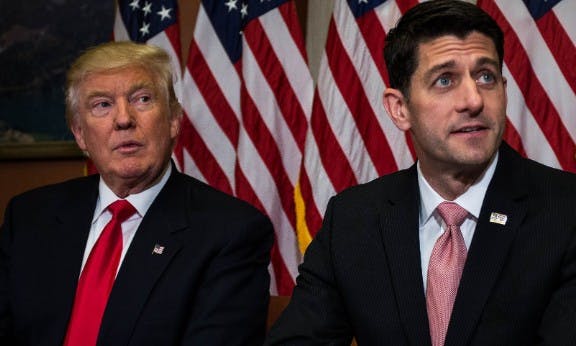The strongman falls on his face

Donald Trump promised to cut through the disarray in the two parties of capitalism in the US by forcing upon them both a new strongman – himself – who knew how to get things done and “make great deals”.
The Republican health insurance debacle not only cut him down to size, but represented the triumph of that very disarray over the president. The strongman proved to be not so strong; the deal maker couldn’t close the deal.
The cause of the failure wasn’t the opposition of the Democrats but deep divisions in the Republican Party. The united front in the party to elect Trump and secure Republican control of both houses of Congress, the executive and the Supreme Court, blew apart.
The immediate issue was the Republican promise, reiterated by Trump, to “repeal and replace” the Affordable Care Act (“Obamacare”), which was enacted in 2010.
What is the ACA? The basic idea was first proposed by the ultra-conservative Heritage Foundation in 1989, as a bulwark against any proposal for government-funded universal health insurance. It relied on the insurance companies for voluntary compliance, with some provisions to aid those individuals who couldn’t afford to buy insurance.
It succeeded in enrolling about 20 million more in some kind of health insurance program, and made some positive proposals such as requiring the insurance companies not to turn down applicants because they had existing medical conditions.
However, it left 26 million uninsured. Because it relied on the insurance companies, premiums began to rise. Extra charges, called “co-payments”, also rose. Many insurance companies pulled out of the program. This trend priced many people out of health care.
Republican politicians oppose any government program for health insurance. Since Obamacare’s enactment, the House Republicans have voted around 50 times to repeal the ACA. They didn’t have any intention of replacing it, just eliminating it.
But it became evident in the course of the Democratic Party primaries that the proposal by Bernie Sanders to replace Obamacare with a single-payer health insurance system had wide support. Polls show that such a proposal is supported by 60 percent of people. Trump and the Republicans then began to talk of “repeal and replacement” of Obamacare.
Trump campaigned on the promise to provide coverage “for everyone”. He also promised to keep Medicaid, a deeply flawed program of subsidies to those too poor to buy health insurance. Obamacare expanded Medicaid, but left its implementation in the hands of the states, which meant a patchwork of insufficient coverage in the different states.
After his inauguration, Trump reneged. He delegated to House speaker Paul Ryan and the new health secretary Tom Price the job of coming up with a health care plan. Both are against government having any role in health insurance, but they had to come up with a “replacement” bill, the American Health Care Act.
What they proposed was to repeal the ACA and eliminate taxes on the wealthy that helped fund Obamacare, and to make severe cuts to Medicaid, among other retrograde proposals.
The Congressional Office of Budget Management estimated that the Republican plan would strike 14 million from the rolls of the insured in 2018, the first year of its implementation, and a total of 24 million in 10 years, largely because of the gutting of Medicaid. So much for the promise that “everyone” would be covered.
Republican “moderates”, especially in the Senate, were alarmed. They could lose their seats! On the other side was the Freedom Caucus, ultra-conservatives who wanted repeal but no replacement, who claimed that the bill was “Obamacare light”.
Trump went on a very public campaign in support of the bill and twisted opponents’ arms. When the Freedom Caucus by and large remained opposed, Trump and Ryan switched to begging, proposing more and more amendments further attacking Medicaid, and eliminating requirements for insurance companies to cover many other things, such as maternal and mental health care.
But this display of weakness only emboldened opponents. The bill was withdrawn.
The failure of Trump’s strong-arm tactics, followed by the failure of his abject pleading, underscore the emptiness of his boasts to take charge and set things right.
Trump now proposes that the Congress take on another of his promises: tax reform. Most Republicans are on board to slash taxes on corporations and the wealthy, under the discredited notion that this will spur investment.
But there is no agreement on how to do this. “Balanced budget” fetishists want to cut major social programs like Social Security and Medicare, the government health insurance program for older Americans. This is politically untenable and would be opposed by a large majority, including many who voted for Trump.
Some propose to replace the tax cuts on the wealthy with other taxes, such as consumption taxes that disproportionately affect people on lower incomes. Another idea, in line with Trump’s economic nationalism, is duties on imports. Trump proposes to streamline the tax code and eliminate its many loopholes. But every one of these suggestions contains flaws and is opposed by various sections of the ruling class.
Will this mess be resolved, or will tax reform go the way of the health insurance bill?
Trump has also proposed vast infrastructure investment, which will run into the same problems as tax reform, since there is strong opposition among Republicans to increased government spending on any program.
The disarray among the Republicans increases the overall political disarray in bourgeois politics. It was this disarray that propelled Trump’s emergence as the strongman who could set things right in the first place. Now he is part of that disarray.